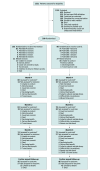Counseling Intervention and Cardiovascular Events in People With Peripheral Artery Disease: A Post Hoc Analysis of the BIP Randomized Clinical Trial
- PMID: 39167413
- PMCID: PMC11339702
- DOI: 10.1001/jamasurg.2024.3083
Counseling Intervention and Cardiovascular Events in People With Peripheral Artery Disease: A Post Hoc Analysis of the BIP Randomized Clinical Trial
Abstract
Importance: It is unclear whether counseling to promote walking reduces the risk of major adverse cardiovascular events (MACE) in people with peripheral artery disease (PAD).
Objective: To test whether a counseling intervention designed to increase walking reduced the risk of MACE in patients with PAD.
Design, setting, and participants: The BIP trial was a randomized clinical trial, with recruitment performed between January 2015 and July 2018 and follow-up concluded in August 2023. Participants with walking impairment due to PAD from vascular departments in the Australian cities of Brisbane, Sydney, and Townsville were randomly allocated 1:1 to the intervention or control group. Data were originally analyzed in March 2024.
Intervention: Four brief counseling sessions aimed to help patients with the challenges of increasing physical activity.
Main outcomes and measures: The primary outcome was the between-group difference in risk of MACE, which included myocardial infarction (MI), stroke, and cardiovascular death. The relationship between Intermittent Claudication Questionnaire (ICQ) scores, PAD Quality of Life (PADQOL) scores, and MACE was examined with Cox proportional hazard regression analyses.
Results: A total of 200 participants were included, with 102 allocated to the counseling intervention (51.0%) and 98 to the control group (49.0%).Participants were followed up for a mean (SD) duration of 3.5 (2.6) years. Median (IQR) participant age was 70 (63-76) years, and 56 of 200 participants (28.0%) were female. A total of 31 individuals had a MACE (composed of 19 MIs, 4 strokes, and 8 cardiovascular deaths). Participants allocated to the intervention were significantly less likely to have a MACE than participants in the control group (10 of 102 participants [9.8%] vs 21 of 98 [21.4%]; hazard ratio [HR], 0.43; 95% CI, 0.20-0.91; P = .03). Greater disease-specific quality of life (QOL) scores at 4 months (ICQ: HR per 1-percentage point increase, 0.97; 95% CI, 0.95-0.99; P < .001; PADQOL factor 3 [symptoms and limitations in physical functioning]: HR per 1-unit increase, 0.91; 95% CI, 0.84-0.98; P = .01) and at 12 months (ICQ: HR per 1-percentage point increase, 0.97; 95% CI, 0.95-0.99; P = .003; PADQOL factor 3: HR per 1-unit increase, 0.91; 95% CI, 0.84-0.98; P = .02) were associated with a lower risk of MACE. In analyses adjusted for ICQ or PADQOL factor 3 scores at either 4 or 12 months, allocation to the counseling intervention was no longer significantly associated with a lower risk of MACE.
Conclusions and relevance: This post hoc exploratory analysis of the BIP randomized clinical trial suggested that the brief counseling intervention designed to increase walking may reduce the risk of MACE, possibly due to improvement in QOL.
Trial registration: anzctr.org.au Identifier: ACTRN12614000592640.
Conflict of interest statement
Figures


Comment on
-
Quality of Life and Clinical Outcomes in Symptomatic Peripheral Artery Disease.JAMA Surg. 2024 Nov 1;159(11):1271. doi: 10.1001/jamasurg.2024.3094. JAMA Surg. 2024. PMID: 39167403 No abstract available.
References
-
- Bonaca MP, Nault P, Giugliano RP, et al. Low-density lipoprotein cholesterol lowering with evolocumab and outcomes in patients with peripheral artery disease: insights from the FOURIER trial (further cardiovascular outcomes research with PCSK9 inhibition in subjects with elevated risk). Circulation. 2018;137(4):338-350. doi: 10.1161/CIRCULATIONAHA.117.032235 - DOI - PubMed
Publication types
MeSH terms
LinkOut - more resources
Full Text Sources
Medical

